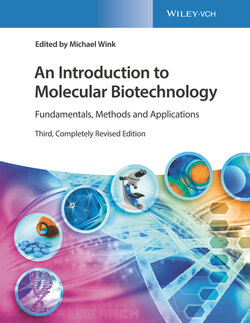Читать книгу An Introduction to Molecular Biotechnology - Группа авторов - Страница 28
3.1.4 Cytoplasm
ОглавлениеThe cytoplasm or cytosol of a eukaryotic cell is what is left when all membrane systems and organelles have been removed. In most cells, this is the largest compartment. In bacteria, it is the only existing compartment. It contains a multitude of low‐molecular‐weight compounds and proteins, including hundreds of regulatory proteins that are interlinked and communicate through complex interaction, such as phosphorylation and dephosphorylation of proteins, modulation by the binding of GTP or GDP, and conformational changes (cell biologists coined the term cross talk for protein interaction). They can pick up signals and pass them on (signal transduction), and it will require extensive research to understand these processes in detail.
At the level of the cellular metabolism, there is a fundamental distinction between catabolism and anabolism. Catabolism is the degradation of organic matter (mostly polysaccharides, protein, and lipids) in order to provide chemical bonding energy through oxidation, which can be transferred to ATP. Polysaccharides are degraded to simple sugars such as glucose. Anabolism is the biosynthesis of monomers (e.g. amino acids, organic acids, and fatty acids) required for macromolecules and of macromolecules and other cell building blocks. Many catabolic and anabolic pathways involve the cytosol, but other compartments may also be involved (Figure 3.22).
Figure 3.22 Synopsis of the breakdown pathways and energy‐producing pathways in heterotrophic organisms (e.g. in humans).
The degradation of glucose to pyruvate is an important energy‐producing process. On balance, glycolysis produces 8 mol ATP per 1 mol glucose (2 mol NADH and 2 mol ATP). Pyruvate is transported into the mitochondria where it is transformed into acetyl CoA while producing NADH. In the mitochondria, acetyl CoA is further processed in the citric acid cycle, using up O2 and releasing CO2 and H2O (Figure 3.15). What matters for the energy balance is the provision of 4 mol NADH, 1 mol FADH2, and 1 mol GTP from 1 mol pyruvate. In the respiratory chain, they produce 12 mol ATP per mol acetyl CoA and 15 mol per 1 mol pyruvate. One mole of glucose, when completely oxidized, produces 38 mol ATP.
Lipids are hydrolyzed into fatty acids by lipases. Fatty acids are particularly rich in energy. During β‐oxidation, they are broken down into acetyl CoA in the mitochondria to provide NADH and FADH2. One mole of stearic acid yields 9 mol NADH, FADH2, and acetyl CoA, which is then further oxidized in the citric acid cycle. The total balance amounts to 9 × 5 + 9 × 12 = 153 mol ATP.
Proteins are broken down by proteases (pepsin, trypsin, and chymotrypsin) into amino acids. These can be entered into the degradation pathways at various stages, thus also producing ATP.
The synthetic pathways of the various low‐molecular‐weight building blocks are complex. They can often be derived from precursors in glycolysis or the citric acid cycle (Figure 3.23). In cell biology, physiology, medicine, and biotechnology, it is important to have a good understanding of these various pathways. This introduction can only scratch the surface, and readers should deepen their knowledge in the relevant textbooks.
Figure 3.23 Importance of glycolysis and the citric acid cycle as a point of departure for diverse biosynthetic pathways. IPP, isopentenyl pyrophosphate; DMAP, dimethylallyl pyrophosphate.
